|
Soybean Disease And Seed Quality Concerns In The Late Season
DR. KAITLYN BISSONNETTE
COLUMBIA, MO.
Soybean disease development had a slow start this season with little disease developing until late in the growing season. High temperatures and dry conditions during the early field season meant minimal development of early and mid-season diseases. Many yield limiting diseases of soybeans require warm temperatures and high relative humidity or free moisture. Frogeye leaf spot, a potentially yield limiting disease that initially appears as tan leaf spots with a brown to purple border (Figure 1), showed up in late July and early August. This disease was primarily observed in more susceptible soybean varieties with overall disease severity remaining low. Frogeye leaf spot requires several hours of moderate temperatures and free moisture, conditions which were lacking in much of the state this year. With drought conditions persisting throughout Missouri, disease pressure remained quite low for much of the year.
One of the few soybean diseases that increases in severity under drought conditions is Charcoal rot, caused by the fungus Macrophomina phaseolina, and was observed in several fields this season. This disease is characterized by the development of black fungal structures called microsclerotia in and on the stems of maturing soybean plants (Figure 2a and b). Symptoms of wilting or early plant senescence without leaf drop can be present, but may be difficult to differentiate from mild to moderate drought symptoms as was the case this season. Microsclerotia produced by this pathogen can survive in the soil for a number of years, so it is important to note in which fields Charcoal rot was observed this year.
The situation changed when the rains began in mid-August, creating ideal conditions for disease development. At that time, many soybeans were still in the early to mid-reproductive stages. With the rains continuing intermittently for several weeks, two major diseases developed that, in addition to the issues associated with drought stress, led to disease-related quality issues and yield losses in some areas of the state.
Cercospora leaf blight and Purple seed stain
Cercospora leaf blight (CLB) and Purple seed stain are caused by a complex of fungi in the genus Cercospora, but are primarily associated with Cercospora kikuchii. This pathogen favors warm temperatures (75-85°F) and high relative humidity with infection occurring during the flowering stages. The severity of CLB is often related to the susceptibility of a soybean variety to the pathogen. In Missouri, CLB occurs every year with characteristic bronzing of the leaves (Figure 3) beginning in the late reproductive stages (around seed filling) and the development of small sunken lesions on the stem and petioles. Once leaf bronzing begins, a result of the accumulation of the toxin Cercosporin in the leaf tissue that is reacting to sunlight, infection of the tissue has already been established. Seed infection by CLB causing fungi often results in a purple discoloration of affected seeds, also referred to as Purple seed stain. Seed affected by Purple seed stain are not often directly associated with yield loss, but can result in quality losses at the elevator and poor seed germination.
This year, symptoms of CLB were observed throughout much of Northern and Central Missouri and was particularly severe in more susceptible varieties. Additionally, reports of Purple seed stain affected seed were widespread and came from grain elevators, crop consultants, and through personal observations (Figure 4). Management of these diseases relies upon crop rotation, planting certified or fungicide treated seed, and the selection of resistant varieties. It is important to note which varieties were severely affected by CLB or Purple seed stain this growing season when making future seed decisions as variety susceptibility plays a significant role in disease severity. Some fungicides also are labeled for managing CLB when applied during pod development and early seed filling, but may not result in increases in seed quality.
Diaporthe/Phomopsis fungal complex
A second set of diseases caused by the Diaporthe/Phomopsis fungal complex also were observed throughout the state following a warm, wet August that led into a warm, wet September and a delayed harvest. Stem canker, Pod and stem blight, and Phomopsis seed decay are all diseases that belong to this fungal disease complex. Dry conditions during much of the early season meant little Stem canker developed until much closer to maturity. Pod and stem blight and Phomopsis seed decay began to show in some areas after warm, wet conditions during soybean maturation allowed for extensive fungal growth. Delayed harvest only increased the severity of these diseases.
Characteristic symptoms and signs of infection by the Diaporthe/Phomopsis fungal complex include: straight lines of pycnidia (black fungal structures on the stem) indicative of pod and stem blight, chalky white, shriveled seeds of Phomopsis seed decay, and general “zoning” of the internal tissues of the lower stem (Figure 5). The “zoning” of the inner tissue was once thought to be related to Charcoal rot, but has since been found to be part of the Diaporthe/Phomopsis complex of disease. These diseases are generally controlled through selecting pathogen-free seed, the use of seed treatments when infection is low to moderate, planting full-season varieties, crop rotation to non-hosts, and timely harvest.
It is important to note that the discoloration of the stems and pods can also be related to secondary saprophytes, opportunistic fungi that feed on dead tissues such as mature soybean stems and pods. Proper identification is critical for the development of effective management strategies, especially for the selection of resistant varieties. More information on sample diagnosis and submission to the MU Plant Diagnostic Clinic can be found online at http://plantclinic.missouri.edu/ or via email at plantclinic@missouri.edu. ∆
DR. KAITLYN BISSONNETTE: Department of plant pathology, University of Missouri
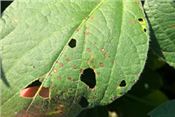
Figure 1 Lesions of Frogeye leaf spot on the upper surface of a soybean leaf.
Note the tan leaf spots with a purple to brown border.
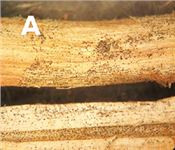
Figure 2 Microsclerotia of the fungus Macrophomina phaesolina, causal agent of Charcoal rot on and in the lower stem of a mature soybean (A). These microsclerotia are embedded in soybean tissues (B) and can survive for several years in the soil.
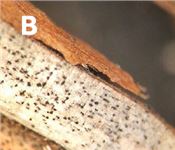
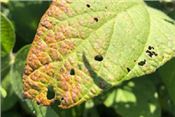
Figure 3 Characteristic leaf bronzing of Cercospora leaf blight resulting from the accumulation of a
produced by Cercospora kukuchii in the leaf tissue and its reaction to sunlight.
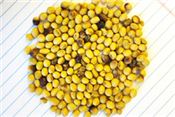
Figure 4 A sample of poor quality soybean seed from central Missouri with evidence of
drought stress and infection by fungi responsible for Purple seed stain.
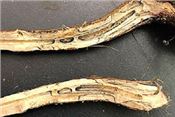
Figure 5 "Zoning" of the lower stem in a soybean plant infected by pathogens in the
Diaporthe/Phomopsis fungal complex.
|
|